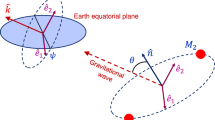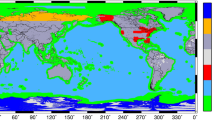Abstract
We report observations of Neptune made in H-(1.4–1.8 μm) and K’-(2.0–2.4 μm) bands on 14 and 16 July 2009 from the 10-m W.M. Keck II Telescope using the near-infrared camera NIRC2 coupled to the Adaptive Optics (AO) system. We track the positions of 54 bright atmospheric features over a few hours to derive their zonal and latitudinal velocities, and perform radiative transfer modeling to measure the cloud-top pressures of 50 features seen simultaneously in both bands.
We observe one South Polar Feature (SPF) on 14 July and three SPFs on 16 July at ∼65 °S. The SPFs observed on both nights are different features, consistent with the high variability of Neptune’s storms.
There is significant dispersion in Neptune’s zonal wind velocities about the smooth Voyager wind profile fit of Sromovsky et al. (Icarus, 105:140, 1993), much greater than the upper limit we expect from vertical wind shear, with the largest dispersion seen at equatorial and southern mid-latitudes. Comparison of feature pressures vs. residuals in zonal velocity from the smooth Voyager wind profile also directly reveals the dominance of mechanisms over vertical wind shear in causing dispersion in the zonal winds.
Vertical wind shear is not the primary cause of the difference in dispersion and deviation in zonal velocities between features tracked in H-band on 14 July and those tracked in K’-band on 16 July. Dispersion in the zonal velocities of features tracked over these short time periods is dominated by one or more mechanisms, other than vertical wind shear, that can cause changes in the dispersion and deviation in the zonal velocities on timescales of hours to days.















Similar content being viewed by others
Notes
Two descriptions of the deviation in zonal velocities from the smooth Voyager wind profile are used throughout. ΔV lon,σ , which is presented here, takes into account uncertainty in the smooth Voyager wind profile. For a feature that is faster than the smooth Voyager wind profile, ΔV lon,σ ≡ V lon −(V voy +σ voy ), where V voy and σ voy are the zonal velocity and its uncertainty predicted by the smooth Voyager profile at the latitude of the feature considered. For a feature that is slower than the smooth Voyager profile, ΔV lon,σ ≡ V voy −σ voy −V lon . According to this definition, a positive value of ΔV lon,σ greater than its uncertainty represents a feature with significant deviation in zonal velocity, while a negative value of ΔV lon,σ represents a feature that is consistent with the smooth Voyager profile. The quantity ΔV lon ≡ V lon −V voy measures deviation from the smooth Voyager wind profile without consideration of uncertainty in the latter. This quantity is used mainly when comparing deviation of two features or sets of features. These quantities are specified in context. A Graphical illustration of these two definitions of deviation is shown in the top legend of Fig. 9.
We note that Voyager and HST observations were mainly at visible wavelengths and are probably sensing more deeply than K’-band images.
References
Allison, M., Ferguson, J.W.: Geophys. Res. Lett. 17, 2269 (1990)
Asay-Davis, X.S., Marcus, P.S., Wong, M.H., de Pater, I.: Icarus 203, 164 (2009)
Baines, K.H., Smith, W.H.: Icarus 85, 65 (1990)
Baines, K.H., Mickelson, M.E., Larson, L.E., Ferguson, D.W.: Icarus 114, 328 (1995)
Borysow, J., Trafton, L., Frommhold, L., Birnbaum, G.: Astrophys. J. 296, 644 (1985)
Borysow, J., Frommhold, L., Birnbaum, G.: Astrophys. J. 326, 509 (1988)
Borysow, A.: Icarus 92, 273 (1991)
Borysow, A.: Icarus 96, 169 (1992)
Borysow, A.: Icarus 106, 614 (1993)
Colina, L., Bohlin, R.C., Castelli, F.: Astron. J. 112, 307 (1996)
Conrath, B., Flasar, F.M., Hanel, R., Kunde, V., Maguire, W., Pearl, J., Pirraglia, J., Samuelson, R., Cruikshank, D., Horn, L.: Science 246, 1454 (1989)
Conrath, B.J., Flasar, F.M., Gierasch, P.J.: J. Geophys. Res. 96, 18931 (1991)
Conrath, B.J., Gautier, D., Owen, T.C., Samuelson, R.E.: Icarus 101, 168 (1993)
Crisp, D., Trauger, J., Stapelfeldt, K., Brooke, T., Clarke, J., Ballester, G., Evans, R. (WFPC2 Science Team): Bull. Am. Astron. Soc. 26, 1093 (1994)
de Pater, I., Gibbard, S.G., Chiang, E., Hammel, H.B., Macintosh, B., Marchis, F., Martin, S.C., Roe, H.G., Showalter, M.: Icarus 174, 263 (2005)
Fletcher, L.N., Drossart, P., Burgdorf, M., Orton, G.S., Encrenaz, T.: Astron. Astrophys. 514, A17 (2010)
Gibbard, S.G., Roe, H., de Pater, I., Macintosh, B., Gavel, D., Max, C.E., Baines, K.H., Ghez, A.: Icarus 156, 1 (2002)
Gibbard, S.G., de Pater, I., Roe, H.G., Martin, S., Macintosh, B.A., Max, C.E.: Icarus 166, 359 (2003)
Hammel, H.B.: Icarus 80, 14 (1989)
Hammel, H.B., Baines, K.H., Bergstrahl, J.T.: Icarus 80, 416 (1989a)
Hammel, H.B., Beebe, R.F., de Jong, E.M., Hansen, C.J., Howell, C.D., Ingersoll, A.P., Johnson, T.V., Limaye, S.S., Magalhaes, J.A., Pollack, J.B., Sromovsky, L.A., Suomi, V.E., Swift, C.E.: Science 245, 1367 (1989b)
Hammel, H.B., Lockwood, G.J., Mills, J.R., Barnet, C.D.: Science 268, 1740 (1995)
Hammel, H.B., Lockwood, G.W.: Icarus 129, 466 (1997)
Hammel, H.B., Sitko, M.L., Lynch, D.K., Orton, G.S., Russell, R.W., Geballe, T.R., de Pater, I.: Astron. J. 134, 637 (2007)
Hansen, J.E., Pollack, J.B.: J. Atmos. Sci. 27, 265 (1970)
Hueso, R., Legarreta, J., Rojas, J.F., Peralta, J., Pérez-Hoyos, S., del Río-Gaztelurrutia, T., Sánchez-Lavega, A.: Adv. Space Res. 46, 1120 (2010)
Irwin, P.G.J., Teanby, N.A., Davis, G.R., Fletcher, L.N., Orton, G.S., Tice, D., Hurley, J., Calcutt, S.B.: Icarus 216, 141 (2011)
Jacobsen, R.A., Owen, W.M. Jr.: Astron. J. 128, 1412 (2004)
Karkoschka, E., Tomasko, M.G.: Icarus 211, 780 (2011)
Karkoschka, E.: Icarus 215, 439 (2011a)
Karkoschka, E.: Icarus 215, 759 (2011b)
Lecacheux, A., Zarka, Ph., Desch, M.D., Evans, D.R.: Geophys. Res. Lett. 20, 2711 (1993)
Lii, P.S., Wong, M.H., de Pater, I.: Icarus 209, 591 (2010)
Limaye, S.S., Sromovsky, L.A.: J. Geophys. Res. 96, 18941 (1991)
Lindal, G.F., Lyons, J.R., Sweetnam, D.N., Eshleman, V.R., Hinson, D.P., Tyler, G.L.: Bull. Am. Astron. Soc. 22, 1106 (1990)
Luszcz-Cook, S.H., de Pater, I., Ádámkovics, M., Hammel, H.B.: Icarus 208, 938 (2010)
Luszcz-Cook, S.: Millimeter and near-infrared observations of Neptune’s atmospheric dynamics. Ph.D. Thesis, University of California, Berkeley (2012)
Martin, S.C., de Pater, I., Marcus, P.: Astrophys. Space Sci. 337, 65 (2012)
Max, C.E., Macintosh, B.A., Gibbard, S.G., Gavel, D.T., Roe, H.G., de Pater, I., Ghez, A.M., Acton, D.S., Lai, O., Stomski, P., Wizinowich, P.L.: Astron. J. 125, 364 (2003)
Mitchell, J.L., Ádámkovics, M., Caballero, R., Turtle, E.P.: Nat. Geosci. 4, 589 (2011)
Polvani, L.M., Wisdom, J., Dejong, E., Ingersoll, A.P.: Science 249, 1393 (1990)
Pravdo, S.H., Shaklan, S.B., Wiktorowicz, S.J., Kulkarni, S., Lloyd, J.P., Martinache, F., Tuthill, P.G., Ireland, M.J.: Astrophys. J. 649, 389 (2006)
Rages, K., Hammel, H.B., Lockwood, G.W.: Icarus 159, 262 (2002)
Smith, B.A., et al.: Science 246, 1422 (1989)
Sromovsky, L.A., Limaye, S.S., Fry, P.M.: Icarus 105, 140 (1993)
Sromovsky, L.A., Limaye, S.S., Fry, P.M.: Icarus 118, 25 (1995)
Sromovsky, L.A., Fry, P.M., Baines, K.H., Dowling, T.E.: Icarus 149, 435 (2001a)
Sromovsky, L.A., Fry, P.M., Dowling, T.E., Baines, K.H., Limaye, S.S.: Icarus 149, 459 (2001b)
Sromovsky, L.A., Fry, P.M., Dowling, T.E., Baines, K.H., Limaye, S.S.: Icarus 150, 244 (2001c)
Sromovsky, L.A., Fry, P.M., Baines, K.H.: Icarus 156, 16 (2002)
Sromovsky, L.A., Fry, P.M., Boudon, V., Campargue, A., Nikitin, A.: Icarus 218, 1 (2012)
Stone, E.C., Miner, E.D.: Science 246, 1417 (1989)
van Dam, M.A., Le Mignant, D., Macintosh, B.A.: Proc. SPIE 5490, 174 (2004)
Warwick, J.W., et al.: Science 246, 1498 (1989)
Acknowledgements
The authors would like to thank Adam Becker for useful discussions. This research has been supported in part by the National Science Foundation Science and Technology Center for Adaptive Optics, managed by the University of California at Santa Cruz under cooperative agreement No. AST 9876783, as well as by NSF Grant AST-0908575 to the University of California. The data presented here were obtained at the W.M. Keck Observatory, which is operated as a scientific partnership among the California Institute of Technology, the University of California and the National Aeronautics and Space Administration. The Observatory was made possible by the generous financial support of the W.M. Keck Foundation. The authors extend special thanks to those of Hawaiian ancestry on whose sacred mountain we are privileged to be guests. Without their generous hospitality, none of the observations presented would have been possible.
Author information
Authors and Affiliations
Corresponding author
Rights and permissions
About this article
Cite this article
Fitzpatrick, P.J., de Pater, I., Luszcz-Cook, S. et al. Dispersion in Neptune’s zonal wind velocities from NIR Keck AO observations in July 2009. Astrophys Space Sci 350, 65–88 (2014). https://doi.org/10.1007/s10509-013-1737-2
Received:
Accepted:
Published:
Issue Date:
DOI: https://doi.org/10.1007/s10509-013-1737-2




